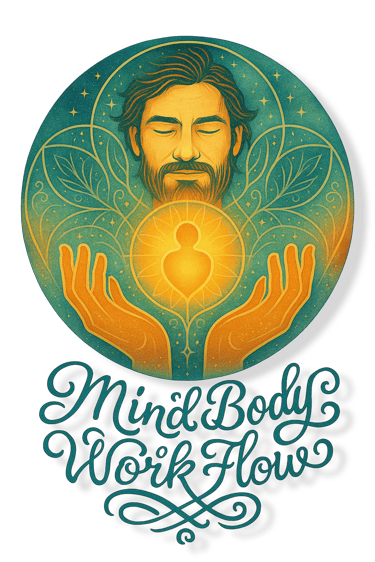
Blog post: How the Body Holds Wisdom - Listening Before Fixing
Discover how your body carries stories, memories, and wisdom beyond words. Before rushing to fix or heal, we can learn to listen — through sensation, breath, and presence. This post explores the art of witnessing your body’s truth and allowing transformation to unfold naturally. Keywords: body wisdom, psychosomatic awareness, somatic healing, embodiment practice, listening to the body
BLOG CONTENTRESOURCES


In modern culture, we are taught to fix things. A broken phone. A sore back. A heavy emotion. But when it comes to the human experience - to our bodies, hearts, and nervous systems - the path to healing rarely begins with fixing. It begins with listening.
Before we can change anything, we must first learn to listen to the body - to its subtle language of tension and release, contraction and expansion, stillness and movement. Because in every sensation, the body is not just reacting; it is speaking.
The Body as a Living Story
The body is not a machine to be repaired. It is a living story - one that remembers.
Each muscle holds memories of past experiences: moments of joy, fear, effort, or surrender. Every breath carries traces of how we have learned to survive. When you pay attention closely, you may notice that the tightness in your shoulders or the knot in your stomach does not only belong to today - it belongs to your history.
This is where the essence of psychosomatic bodywork begins: understanding that the body and the mind are never separate. They are in a constant, intimate dialogue - one that shapes who we are and how we feel. Your body knows long before your mind can make sense of things. It holds wisdom that words cannot always reach.
Why Listening Matters More Than Fixing
Fixing often comes from judgment - from the belief that something is wrong with us. Listening, however, begins with curiosity and compassion.
When we approach our pain or tension with an agenda to "get rid of it," the body tends to protect itself, to close even tighter. But when we meet the same place with presence - with open attention and the willingness to feel - the body begins to soften. It begins to trust.
This is the foundation of somatic therapy and embodiment practice: creating space for the body to express what it already knows. Transformation happens not because we force it, but because we witness it.
How the Body Speaks
The body communicates through sensations - the language beneath language.
A flutter in the chest might signal excitement or vulnerability.
A heaviness in the gut could be fear, or truth waiting to be acknowledged.
A holding in the jaw might be unspoken words - a boundary never voiced.
In psychosomatic bodywork, we tune into these messages without over-analyzing. We notice what expands and what contracts. We follow the rhythms of breath, the rise of emotion, the subtle pulse of energy through the spine. This listening becomes a practice of presence - a way to meet ourselves exactly as we are, without trying to be different.
Listening Before Fixing in Practice
So what does it mean, practically, to listen before fixing? It might look like this:
When your chest tightens, you pause instead of pushing through.
When emotion rises, you breathe instead of analyzing.
When pain appears, you ask, "What are you trying to tell me?" instead of "How can I make you go away?"
This does not mean we never act. It means that our actions begin from understanding, not avoidance. From the inside out, not the outside in.
When we slow down enough to hear what the body is expressing, we begin to notice patterns: the urge to hold our breath when we feel unsafe; the subtle collapse when we feel unseen; the habitual tension that says, "I must hold it all together." Through witnessing, the body reveals its natural intelligence - always seeking balance, connection, and flow.
The Intelligence Beneath the Surface
In embodiment work, we often say: the body never lies. It might hide. It might protect. But it never lies.
Every contraction once had a purpose - to keep us safe, to help us belong, to hold what could not be held at the time. When we meet these places with awareness instead of correction, something shifts. We do not erase the story; we integrate it.
True change happens not through effort, but through recognition. When the body feels seen, it no longer needs to hold the same way. When the breath feels space to move again, life itself begins to move again. Listening to the body's wisdom is the foundation of transformation - and psychosomatic bodywork is not a technique of fixing, but of remembering.
From Reaction to Relationship
The journey from fixing to listening is a journey from reaction to relationship. Fixing comes from the mind that wants control. Listening comes from the heart that seeks connection.
In the Pantarei Approach, the dialogue between practitioner and client mirrors the inner dialogue between body and mind. Through touch, breath, and conversation, we feel ourselves more clearly - not as broken beings to be fixed, but as whole systems constantly adapting and evolving. The practitioner does not impose change. They hold space for it to emerge. Awareness opens new possibilities for movement, emotion, and expression.
Why Listening Heals
To be deeply listened to - even by yourself - is to be acknowledged as whole. When you listen to your body without judgment, you invite all parts of yourself back home: the tired parts, the proud parts, the forgotten and the wild parts. They all belong.
As you hear yourself more clearly, you trust yourself more deeply. The body stops being an obstacle and becomes an ally - a compass pointing toward what is real, what is needed, and what is ready to unfold. Psychosomatic healing remembers that body and soul are not separate, and transformation begins the moment you listen.
Listening Before Fixing - A New Paradigm
Imagine what might happen if, instead of rushing to fix what hurts, you paused and simply felt. If you placed your hand on the place that aches and whispered: "I'm here. I'm listening."
That moment of presence can shift everything. The body does not need to be forced into healing. It only needs to be heard.
If you would like to experience this work, book a session in person or online:


